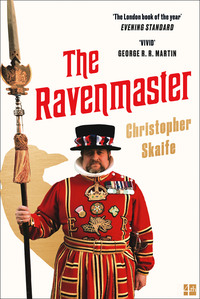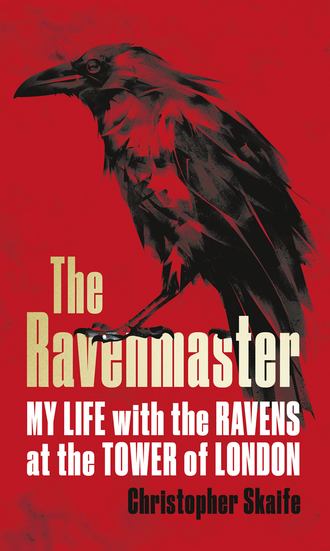
Полная версия
The Ravenmaster: My Life with the Ravens at the Tower of London

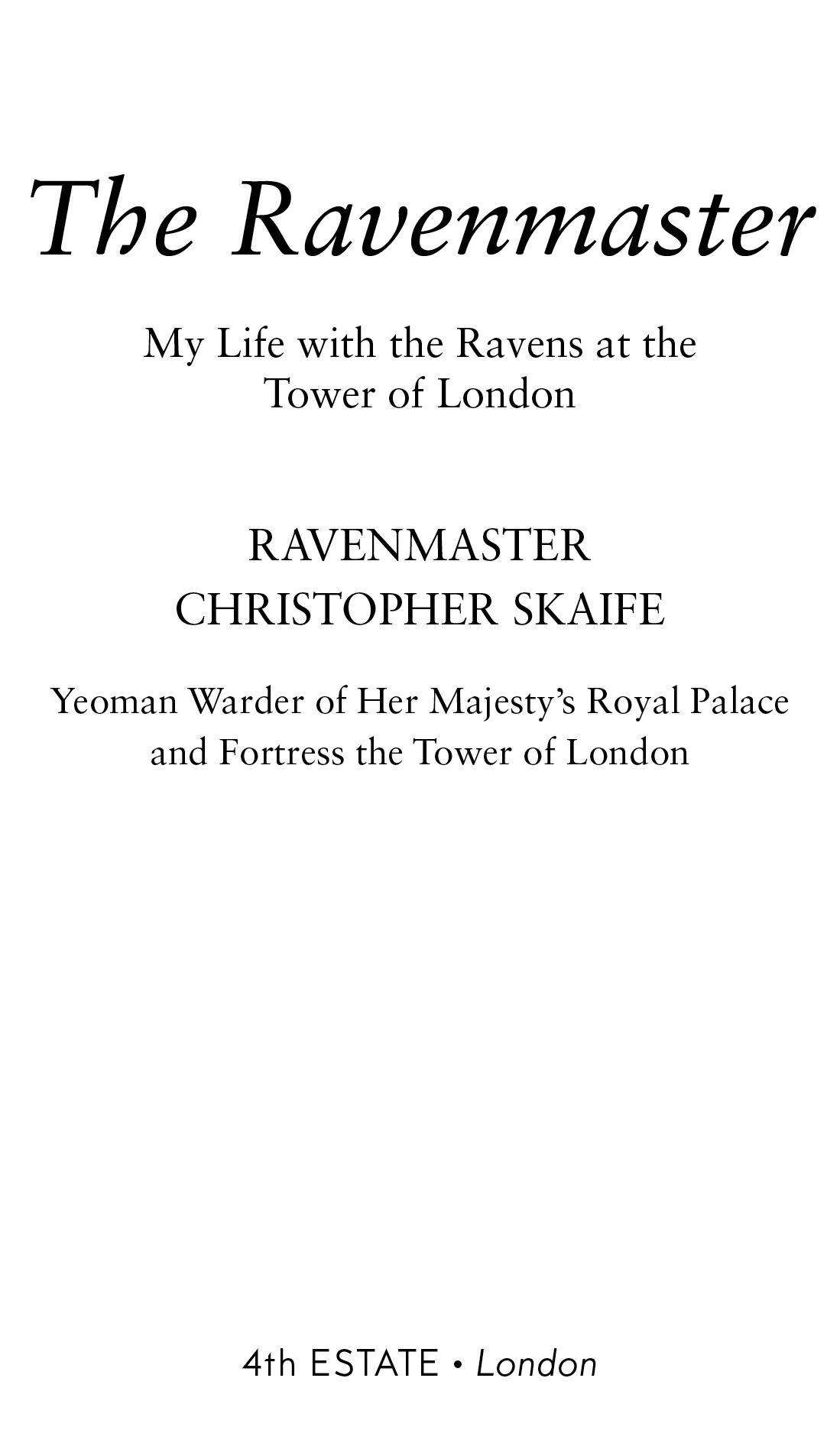
Copyright
4th Estate
An imprint of HarperCollinsPublishers
1 London Bridge Street
London SE1 9GF
www.4thEstate.co.uk
This Ebook first published in Great Britain by 4th Estate in 2018
Copyright © 2018 by Historic Royal Palaces Enterprises Ltd 2018
The right of Historic Royal Palaces Enterprises Ltd to be identified as the copyright-holder of this work has been asserted in accordance with the Copyright, Design and Patents Act 1988
Map © Richard Wells
A catalogue record of this book is available from the British Library
All rights reserved under International and Pan-American Copyright Conventions. By payment of the required fees, you have been granted the non-exclusive, non-transferable right to access and read the text of this e-book on screen. No part of this text may be reproduced, transmitted, down-loaded, decompiled, reverse engineered, or stored in or introduced into any information storage and retrieval system, in any form or by any means, whether electronic or mechanical, now known or hereinafter invented, without the express written permission of HarperCollins.
Source ISBN: 9780008307929
Ebook Edition © October 2018 ISBN: 9780008307905
Version: 2018-08-10
Dedication
To the ravens of Her Majesty’s Royal Palace and Fortress the Tower of London
And to the memory of Martin Harris
Contents
Cover
Title Page
Copyright
Dedication
Map
1 Silhouette
2 Ravenmaster
3 The Rules
4 Roll Call
5 Bird Life
6 Tower Green
7 Biscuits and Blood
8 The Menagerie
9 Black Birds
10 The Raven Spreads His Wings
11 The Great Escape
12 Resistance to Interrogation
13 Citizens of the World
14 Double-Hatting
15 The Story
16 Application
17 Speaking in Ravenish
18 Bird Brains
19 Ravenology
20 The Legend of the Ravens at the Tower
21 Blood Swept Lands and Seas of Red
22 My Mistress’ Eyes Are Raven Black
23 Birds and Books
24 Death and the Raven
25 The Ghosts of My Life
26 And So to Bed
27 Great Traditions
28 Sentinels of the White Tower
29 Rising Above
Appendix: Ravenmasters Since 1946
Acknowledgements
Suggested Reading
About the Publisher
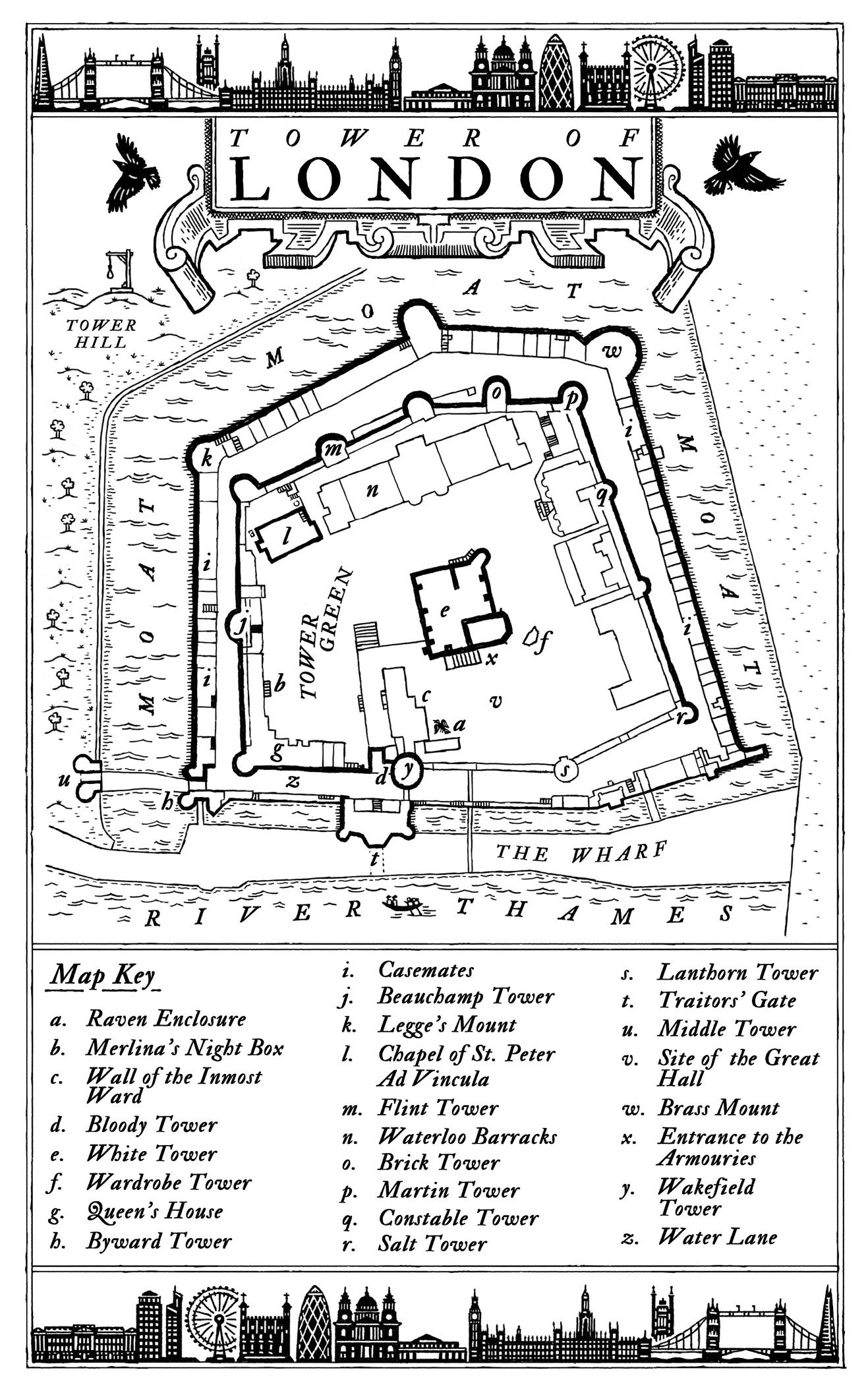
1
Silhouette
0530. Autumn. First light over London. I’m up and out of bed before the alarm. I get dressed in the dark and head straight out the door. No time even for a cup of tea. There’s always that niggling concern that something might have gone wrong overnight. And if things go wrong, things can go badly wrong.
I can already hear the lorries and the white vans and the early-morning commuters coming into town. Tower Bridge Road, Fenchurch Street, London Bridge. There’s that hum – the sound of the City awakening.
I hurry up the stone spiral staircase by the Flint Tower, the London skyline bright with lights and winking behind me. I see the old Port of London Authority Building, which is now home to a fancy hotel, but was once responsible for the comings and goings of ships all the way up and down the Thames. Behind that stand the Cheesegrater and the Walkie-Talkie and the Gherkin, the big new skyscrapers with their funny little nicknames.
Past the Chapel and the Waterloo Barracks and out onto Tower Green and there’s that proper morning smell of London, that mixture of exhaust fumes, the river, fresh-ground coffee, and the beautiful sweet incongruous smell of fresh-cut grass on Tower Green. Tower Bridge is hunched up ahead, with HMS Belfast reliably anchored on the river to the south.
There’s no one around in the Tower, just me and the shadows of a thousand years of history.
I call out, and at first there’s nothing but silence. I call out again. There’s always that moment of fear as I scan the skyline. But then I see her: perched on one of the rooftops of the Tower buildings, a silhouette against the blue-grey dawn.
‘Good morning,’ I say.
And a good morning it is.
The ravens are at home in the Tower.
I can breathe easy again – the kingdom is safe for another day.
2
Ravenmaster
I have what is often described as the oddest job in Britain.
Odd? Maybe.
The best? Definitely.
My name is Chris Skaife and I am the Ravenmaster at the Tower of London.
My official title is Yeoman Warder Christopher Skaife, of Her Majesty’s Royal Palace and Fortress the Tower of London, and member of the Sovereign’s Body Guard of the Yeoman Guard Extraordinary, which is generally believed to be the oldest formed ‘Body of Men’ in the world still in existence, dating back to the reign of King Henry VII sometime after the Battle of Bosworth Field in 1485. All of us Yeoman Warders are former soldiers, male and female, with at least twenty-two years of unblemished service. We are the ceremonial guardians of the Tower of London. In principle we’re responsible for looking after any prisoners at the Tower and safeguarding the Crown Jewels. In practice, we act as tour guides and as custodians of the rituals of the Tower. We live right here, in the Tower. They say that every man’s home is his castle: for us, it’s literally the case.
How can I begin to explain the Tower to you? It was built as a fortress and a Royal Palace, but it’s also been a prison, an arsenal, and the site of the Royal Mint and the Royal Armoury. One of the great early English historians, John Stow – who grew up about half a mile from the Tower – summed it up best in his Survey of London, published in 1598: ‘This Tower is a citadel to defend or command the city; a royal palace for assemblies or treaties; a prison of state for the most dangerous offenders; the only place of coinage for all England at this time; the armoury for warlike provision; the treasury of the ornaments and jewels of the crown; and general conserver of the most records of the king’s courts of justice at Westminster.’ That just about covers it. These days we welcome around three million visitors every year.
There are plenty of famous places for tourists and locals to visit in London. There’s Westminster Abbey, there are the Houses of Parliament, Buckingham Palace, Kensington Palace, Kew Gardens, Hampton Court Palace, the British Museum, the Imperial War Museums, the V & A, the Science Museum, the Natural History Museum. The list goes on and on. If you’re the sort of person who wants to see a nice Baroque interior then off you can go to a Hawksmoor church, or if you fancy a nice bit of post-war Brutalism there’s the Royal Festival Hall. If you’re looking for a good view you can go to Hampstead Heath or Primrose Hill, or up to the top of the Shard. You’ve got your theatres and your concert halls and your restaurants and cafés. But in my opinion – my humble opinion – the Tower remains without a doubt one of London’s great attractions.
Why? Well, there’s the obvious fact that we’re one of the first attractions. When William the Conqueror defeated King Harold at the Battle of Hastings back in 1066 he decided he needed a sign of his triumph, a monument to his great power and strength, and so sometime around the late 1070s work began on the White Tower, the biggest and boldest building ever undertaken in England. The Tower was intended as a symbol of power and remains so today: in my opinion the finest example of statement architecture in the country. London may be forever reinventing itself, but the Tower remains. Much of the old City was destroyed in the Great Fire of 1666. Since then, Newgate Prison has gone. Old London Bridge has gone. The great warehouses around St Katharine Docks have gone. Even during my time at the Tower, London has been transformed: the Shard, the Gherkin, the Walkie-Talkie; Crossrail; the Docklands Light Railway; the gentrification of the East End. Yet right in the middle of it all we still have the Tower. It has seen it all, done it all, been part of it all. It has incredible architecture. Pageantry. A bloody history of murder and torture. And – of course – it has the ravens.
We currently have seven ravens at the Tower. As the Ravenmaster I’m the person responsible for their safety, security and welfare. I look after the ravens – and the ravens look after us. Without the ravens, so the legend goes, the Tower itself will crumble into dust and great harm will befall the kingdom.
This book will attempt to answer some of the most common questions I get asked about the Tower ravens. Why are there ravens at the Tower in the first place? Where do our myths and superstitions about the birds come from? How do I care for them? What do I feed them? Who gets to name them? What happens to them when they die? How and why do they stay at the Tower?
What this book is not – I should state clearly at the outset – is a scientific study. I am not a scientist, though over the years I’ve been fortunate to meet with and assist the many scientists who have come and studied our birds and who have written about them in academic journals and reports. Despite my many years of experience looking after the ravens, I don’t have any official bird-related credentials or qualifications. I am not a professional ornithologist. I’m really just an average guy with a greater-than-average amount of luck who has been fortunate enough to have spent a large part of my life with some of the most famous birds in the world as they go about their daily business. This book is about my life and work with the Tower ravens, and what it takes to be the Ravenmaster.
I was born and brought up in Dover, in the county of Kent, in the south-east of England. My earliest memory is of when I was barely a toddler, climbing out onto the ledge of our living-room window. I was right there, ready to go, before I was pulled back in. An early bid for freedom. There was another time, a few years later, when I climbed a big old gnarly tree until I was positioned right above our neighbours’ greenhouse – and then I jumped. I wanted to see what would happen. What happened was that I went straight through the glass. I’ve still got the scars to show for it.
By the time I was about fifteen I was bunking off school and going to the woods or up to the local hills as part of a little gang of kids. We kept ourselves busy by lighting fires, drinking cider, stealing stuff, and generally mucking around. We had our sheath knives to build dens and make arrows and we would break into old storerooms and garages to see what was there – just getting up to mischief. We’d buy fireworks and put bangers in car exhausts or fire them out of old plumbing pipes. We stole a couple of motorbikes and took them up to the hills to go scrambling. We tried to steal a Ford Anglia, but it had a flat battery and we were swiftly caught by the police. I remember getting a thick ear for that.
I wasn’t a bad kid, but I wasn’t the best.
This was 1981. If you switched on the TV it was all the Yorkshire Ripper this, and the Hunger Strikers that, and the Brixton and Toxteth riots, and the National Front were marching, and Enoch Powell was sounding off about a race war, and AIDS was becoming a global crisis, and unemployment figures were skyrocketing. Thatcher was in power. The IRA were bombing and killing soldiers and civilians. It was what you might call a bit of a difficult period in British history.
And there we were, at the beginning of a new decade, boys and girls about to leave school and ready for some adventures of our own.
My parents were getting concerned. I was drinking, smoking, going to parties, sneaking out to sleep up in the hills, getting into fights with other gangs. What was to be done with me?
And then one day an Army Careers Adviser visited the school. It happened to be one of the days I was actually attending classes.
Like many kids back then I had spent a lot of my childhood re-enacting the Second World War, playing with toy soldiers, staging fights and battles with my mates, the Allies versus the Nazis, all that sort of thing, reading the old 1970s war comics, The Victor and Warlord and Battle. There was Dad’s Army on TV, of course, as well as Kojak and The Six Million Dollar Man, and Kung Fu and Planet of the Apes – it was all goodies and baddies and tough guys and fighting. So when the Army Careers Adviser gave us his talk and handed out his leaflets about joining the army – a life full of adventure, a life of goodies and baddies and tough guys and fighting – I thought it seemed like a pretty good idea. I took the leaflets home and talked to my parents, who probably thought, well, if it’s not that, he’s going to end up in jail.
I went with Mum to the old Army Careers Information Office in Dover, which was just a little red-brick hut really, tucked away at the base of the cliffs, by the eastern dock and the ferry terminal, and there was this portly old recruiting sergeant sitting in there and you could see he was bored out of his mind, and all you had to do was a basic literacy and numeracy test and then sign on the dotted line and take the Queen’s shilling and you were in, more or less. So I did.
It was the best decision I ever made.
Off I went to Deepcut Barracks to do a fitness test, interviews, a general-knowledge test. I was asked if I wanted to learn a trade, because my test results were that good. I may have been a messer, but I wasn’t stupid. I could have trained as an engineer, or even a veterinary nurse. I could have learned a proper trade, but by that time the Falklands War had started and I just wanted to learn to fire a gun and be a soldier and get on with it. So I chose to go in as a good old-fashioned regular soldier. I left school, my parents took me to Dover Priory train station, I waved goodbye to them, and I joined the army as a boy soldier, the Junior Infantry Battalion at Bassingbourn, on 18 June 1982, which as it turned out was just a few days after British forces had recaptured Stanley from the Argentinians, and the Falklands War was over. I was sixteen and a half. That was the beginning of almost twenty-five years in the military – a full-service career which took me all over the world and eventually to the Tower of London and into the lives of my friends, the ravens.
I’m very lucky to have had two careers: as a soldier and now as a Yeoman Warder. As a soldier I saw the best and worst of what humans are capable of. As the Ravenmaster I’ve been granted a privileged insight into the lives and behaviour of some of the world’s most extraordinary non-human creatures. One of the things I’ve learned from the ravens is that they’re surprisingly like us: they are versatile, adaptable, omnivorous, they are capable of great cruelty and great kindness, and on the whole they manage to get along with one another. In learning about the ravens, I have discovered a lot about what it means to be a human: I’ve learned to listen, to observe, and to be still. The ravens have been my teachers and I have been their pupil.
There’s a photograph of me as a young boy on a school trip to London. Trafalgar Square. We’d come up from Kent on the train for the day. It was a real treat – London Town! I’m kneeling, wearing flared trousers and sporting a bowl-cut hairstyle – this was the 1970s, after all – and I am concentrating on feeding the pigeons. You can see from the photo that I am completely and utterly absorbed. You can see the expression on my face, me thinking, what are those birds about?
That fascination is with me still. My hope is that in reading this book you too will become fascinated.
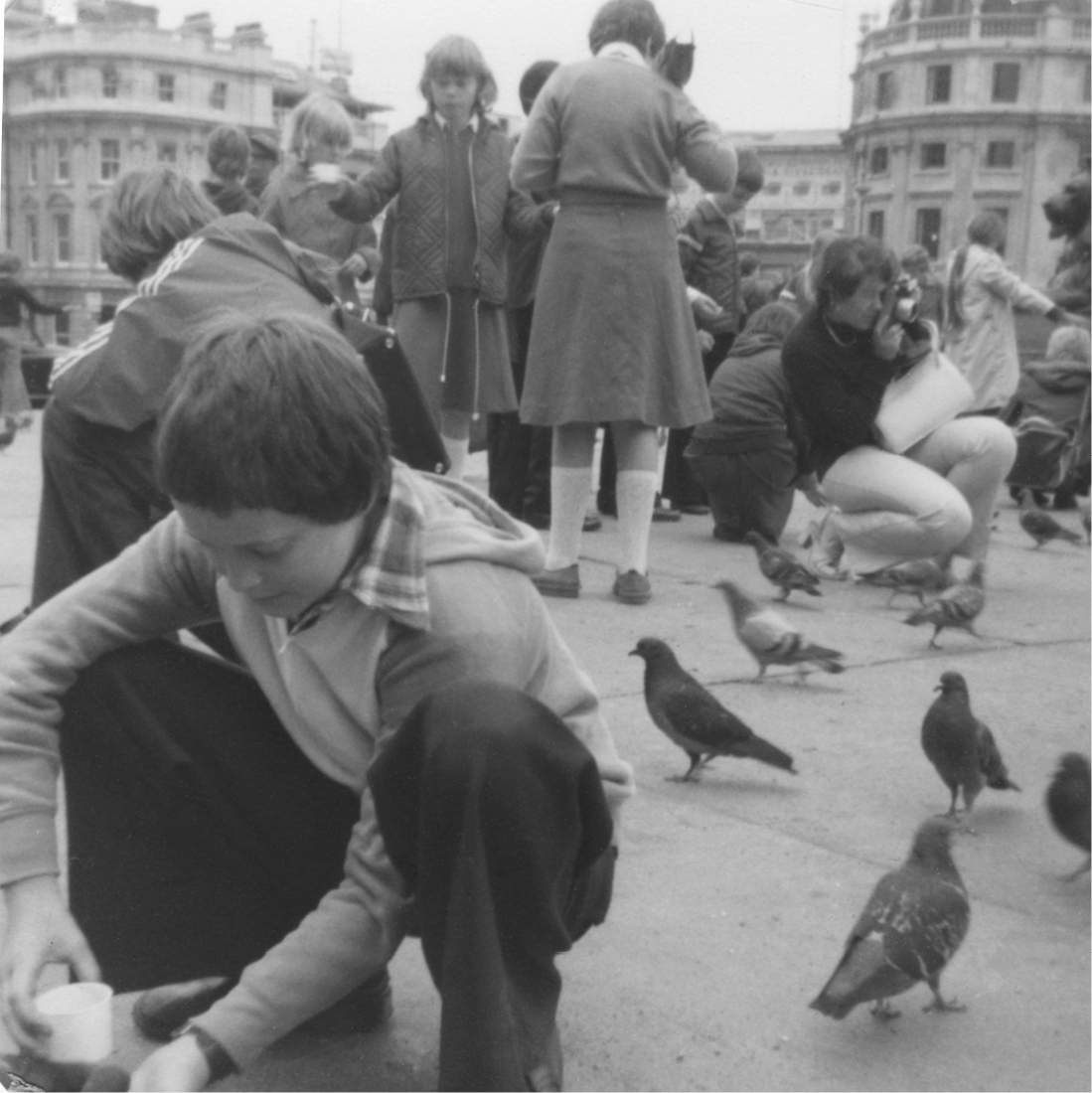
The author in Trafalgar Square, on a 1970s school trip to London. (Courtesy of the author)
3
The Rules
I am, as far as I’m aware, only the sixth Ravenmaster ever to have been appointed at the Tower. Before that, caring for the ravens was part of the job of the Yeoman Quartermaster. Like a lot of our great traditions in Great Britain, the role and indeed the title of Ravenmaster is in fact a recent invention. The story goes that when Henry Johns was appointed Yeoman Quartermaster just after World War II, some of the old Yeoman Warders used to joke that he was raving mad – so keen was he on caring for the birds – and so he affectionately became known as the Raving Master instead of the Quartermaster. It wasn’t until John Wilmington took over from Henry Johns in 1968 that the more sane-sounding title of Raven Master became official, and not until some years later – doubtless due to some clerical error in a back office somewhere – that the Raven Master became known as the Ravenmaster.*
I lead a team of Yeoman Warders here at the Tower who assist me in caring for the birds. They are known as the Ravenmaster’s assistants. I call us Team Raven. Together we are responsible for looking after the ravens 365 days a year. There’s never a day when there’s not a Yeoman Warder on duty responsible for the ravens. They are possibly the most cared-for – and certainly the best-loved – birds in the world.
There are a few simple rules about caring for the Tower ravens that have been passed down to me over the years by my illustrious predecessors, and which I in turn like to pass on to my assistants. The theory goes that if you follow these rules you’ll remain safe around the ravens, and they’ll remain safe around you.
DO NOT hurry the ravens.
DO NOT attempt to change the pecking order.
DO NOT try to cut corners.
DO remain calm at all times.
DO allow the ravens to follow the same routine every day.
DO prepare for chaos if you break any of the above rules.
It goes without saying that I have failed to observe these rules many times – and that the job of Ravenmaster is in fact rather more challenging and complex than following a few basic rules.
As Ravenmaster you have to be able to think on your feet. Over the years I’ve had to deal with bird-on-bird attacks, bird-on-human attacks, human-on-bird attacks, stolen goods, snatched food, biohazard concerns, security problems, disease, death, and tragedy. On a daily basis my job involves dealing with children, tour guides, VIPs, journalists, amateur historians, professional historians, bird-lovers, and all the other assorted visitors to the Tower. By my calculation, in the height of the summer, when our visitor numbers are at their peak, I am photographed about three or four hundred times a day, every day: I reckon the ravens and I have probably featured in someone’s family album in every country in the world. For the love of ravens I’ve nearly drowned, I’ve very nearly fallen off tall buildings, and many’s the time I’ve had to risk my reputation and stick my neck out to try to do what I think’s best for the birds. And it’s not as if they’re exactly grateful. They are not my pets. They do not do tricks. They do not ride unicycles. They do not speak Latin. They don’t necessarily do what I tell them to do – which can be more than a little embarrassing. There was the time one of our ravens affectionately pecked a cameraman on the back of the leg during a television interview about the Tower, for example: that caused a bit of a commotion. They do not perform on cue. The Tower ravens are big, powerful, unpredictable creatures, with a savage bite, who roam freely about the Tower and who have the ability to fly off at any moment if they so desire.
So, you have been warned. You know the rules. Now it’s time to meet the ravens.
* For a full list of Ravenmasters, see the Appendix.
4
Roll Call
As I mentioned, we currently have seven ravens at the Tower. We always have a minimum of six – as decreed, according to legend, by Charles II. These are our magnificent seven.
Munin
Female
Entered Tower service 18 May 1995
Current age: Twenty-three (age on arrival: six weeks)
Presented by Mrs Joyce Ross
Named by Ravenmaster David Cope
Raven Munin is currently the oldest serving raven at the Tower.* Named after one of Odin’s ravens in Norse mythology, she has led what you might call a colourful life.
She is incredibly intelligent – she can solve scientific tests in record time. She is also tough and she is brave: she loves to get as high up around the Tower as she possibly can, which has caused me no end of problems, having to clamber up after her. She’s broken her wing twice and is now permanently on medication to treat her arthritis. She’s had three partners during her time with us – two of them now dead – and so is affectionately known to me and my assistants as the Black Widow.
I’ll be honest: Munin and I have something of a troubled relationship. Basically, she doesn’t like me. In fact, sometimes I think she actually hates me. She’s certainly been giving me the runaround for years. Research suggests that ravens can recognise human faces, and I can only assume that I did something horrendous in my early days as the old Ravenmaster’s assistant and Munin has never forgiven me.
If you ever visit the Tower, you can easily identify Munin because she’s the bird who hops off in the opposite direction whenever she sees me. After many years of niggling, tussling and negotiation, I would describe ours as a relationship of mutual grudging respect.
Merlin/Merlina
Female (but thought male for the first five years of her life)
Entered Tower service May 2007
Current age: Twelve (age on arrival: one)
Place of origin: Somewhere in Wales
Presented by Anne Bird, Barry Swan Rescue Centre
Named by previous owner and officially still known to the Tower as Merlin (renamed Merlina by Ravenmaster Chris Skaife)
Merlina – or Merlin, as she was first known – was found by the side of a road in Wales. She was adopted by a family of bird-lovers who built her an aviary and looked after her until she became too difficult to handle. She is not a bird suited to a quiet suburban life. Her caretakers gave her to the Swan Rescue Centre in Barry, Wales, where she quickly became renowned for throwing tantrums, mimicking other birds, and randomly squawking out a primitive ‘Hello’ and ‘Thank you’ at passersby. After she refused to have anklets placed on her and withdrew all cooperation in her interactions with her carers, the Rescue contacted us at the Tower in desperation. And here she has been, perfectly happy, ever since.




